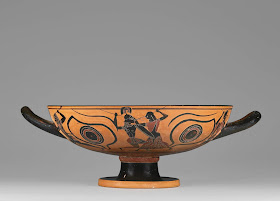 |
| Kalpis ca. 470 BC Getty |
 |
| Kalpis ca. 470 BC Getty |
The kalpis (above) was a water jar. The owl framed by stylized olive branches represented the city of Athens itself. This rare and fragile object is on display at the Getty Villa in Malibu, as are most of the other ancient Greek objects in these photographs. Amphora (below) were used to store and carry food. Very often they were decorated with pictures of violent struggle – either among warriors or against monsters.
 |
| Neck Amphora c. 500-480 BC Getty |
 |
| Neck Amphora c. 550 BC Getty |
Above, Theseus kills the Minotaur while Athenian youths and maidens watch. Without the hero's interference, they would have been eaten. Below, the reverse of the same amphora features hoplites with fancy shields engaged in combat as onlookers wait to congratulate the victor.
 |
| Neck Amphora c. 550 BC Getty |
 |
| Neck Amphora c. 510 BC Getty |
Preceded by his son, Aeneas flees burning Troy on the amphora above, carrying his father Anchises on his shoulders. The goddess Aphrodite (mother of Aeneas) stands behind, mourning the difficult fate of her favorites. Below, a column krater used for mixing wine bears large overlapping profile-heads of the divine couple Dionysos and Ariadne.
 |
| Column Krater c. 530 BC Getty |
 |
| Lekythos c. 420-400 BC Getty |
The lekythos was a special flask for perfumed oil and was often associated with funerals and death. The narrow neck caused the contents to flow out slowly while the wide mouth allowed for easier filling. On the lekythos above, the amorous meeting of Paris and Helen will provide the catalyst for the entire Trojan War. Below, the mythical Garden of the Hesperides, tended by nymphs, is laid out around the sides of another lekythos.
 |
| Lekythos c. 420-400 BC Getty |
 |
| Lekythos c. 450 BC Getty |
Above, a youth in armor confronts a woman with extended hands. His death in battle is foreshadowed, it is said, by the serpent-device on his shield.
The four final images are four different aspects of the same kylix, or wine cup. It depicts goddesses Artemis and Athena battling giants in armor. The eye-motif (supposedly believed by the ancients to ward off evil) was common, with other design elements worked in around the eyes, as here.
 |
| Kylix c. 540-530 BC Getty |
 |
| Kylix c. 540-530 BC Getty |
 |
| Kylix c. 540-530 BC Getty |
 |
| Kylix c. 540-530 BC Getty |